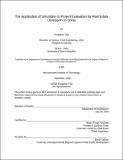| dc.contributor.advisor | Brian (Tony) Ciochetti. | en_US |
| dc.contributor.author | Tian, Yongchun | en_US |
| dc.contributor.other | Massachusetts Institute of Technology. Dept. of Architecture. | en_US |
| dc.coverage.spatial | a-cc--- | en_US |
| dc.date.accessioned | 2007-06-27T20:27:41Z | |
| dc.date.available | 2007-06-27T20:27:41Z | |
| dc.date.copyright | 2006 | en_US |
| dc.date.issued | 2006 | en_US |
| dc.identifier.uri | http://dspace.mit.edu/handle/1721.1/37447 | en_US |
| dc.identifier.uri | http://hdl.handle.net/1721.1/37447 | |
| dc.description | Thesis (S.M.)--Massachusetts Institute of Technology, Dept. of Architecture, 2006. | en_US |
| dc.description | This electronic version was submitted by the student author. The certified thesis is available in the Institute Archives and Special Collections. | en_US |
| dc.description | Includes bibliographical references (leaves 68-69). | en_US |
| dc.description.abstract | For developers in China to calculate project financial returns in order to make investment decisions, the traditional Excel model only gives "point estimate" (i.e. a single value) for each input variable, and therefore the model can only reflect one possible scenario. Yet in reality many different things could happen to any input variable in the financial model, which could also result quite different outcomes. Developers in China face a huge degree of uncertainties including changes in market conditions which impact sale price and time duration of selling the product and fluctuations in construction costs, in addition to the uncertainty of the land cost which is derived from the unique bidding process in China. This thesis will thoroughly illustrate the land policy and some associated unique features in the real estate development in China, followed by an introduction of the financial model currently used by China's developers. The thesis then addresses risk management issue by introducing the Monte Carlo simulation method and by incorporating simulation into the financial model for project evaluation. The thesis will explain how and why simulation can improve the traditional Excel model, and therefore help management to make more informed decisions with enhanced efficiency and accuracy. | en_US |
| dc.description.statementofresponsibility | by Yongchun Tian. | en_US |
| dc.format.extent | 76 leaves | en_US |
| dc.language.iso | eng | en_US |
| dc.publisher | Massachusetts Institute of Technology | en_US |
| dc.rights | M.I.T. theses are protected by copyright. They may be viewed from this source for any purpose, but reproduction or distribution in any format is prohibited without written permission. See provided URL for inquiries about permission. | en_US |
| dc.rights.uri | http://dspace.mit.edu/handle/1721.1/37447 | en_US |
| dc.rights.uri | http://dspace.mit.edu/handle/1721.1/7582 | |
| dc.subject | Architecture. | en_US |
| dc.title | The application of simulation to project evaluation for real estate developers in China | en_US |
| dc.type | Thesis | en_US |
| dc.description.degree | S.M. | en_US |
| dc.contributor.department | Massachusetts Institute of Technology. Department of Architecture | |
| dc.identifier.oclc | 123447930 | en_US |
